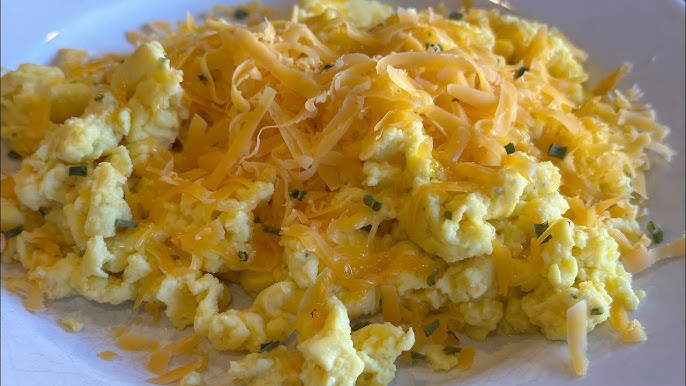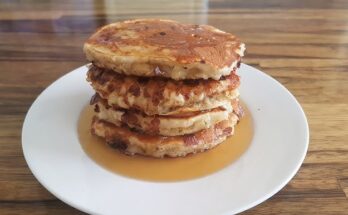Cottage Cheese Eggs Recipe: Looking for the ultimate high-protein, fluffy, creamy scrambled eggs that taste like brunch at a fancy café? This Cottage Cheese Eggs Recipe might just blow your mind. It’s a simple, protein-packed twist on your traditional eggs, and it takes only minutes to make. Whether you’re trying to level up your breakfast game or need a filling low-carb meal, these eggs are going to be your new go-to. Let’s get cracking—literally.
Why You’ll Love This Recipe
There are plenty of egg recipes out there, but this one hits differently. For one, the cottage cheese melts into the eggs, creating an ultra-creamy texture without needing any cream, butter, or milk. It’s fluffy, rich, and completely satisfying.
You’ll also love this recipe because it’s:
- Quick and easy: Ready in under 10 minutes.
- Healthy: Low-carb, high-protein, and keto-friendly.
- Budget-friendly: Uses minimal, affordable ingredients.
- Customizable: You can toss in herbs, veggies, or cheese to match your cravings.
- Perfect for meal prep: Make it in bulk and reheat throughout the week.
These eggs taste like something off a gourmet breakfast menu but with half the effort and calories. Intrigued yet? You should be.
What Makes Cottage Cheese a Game-Changer in Eggs?
You might be thinking, “Cottage cheese… in eggs? Really?” Yes, really—and it’s absolutely a game-changer. Here’s why.
Cottage cheese brings a subtle tang and creaminess that’s hard to replicate. As it heats, it melts slightly into the eggs, giving them a soft, luscious texture. Not only that, but it adds a significant protein punch, making your breakfast more filling and nutritious.
Most people think of cottage cheese as a side snack, but when folded into eggs, it completely transforms the dish. It’s also a clever way to cut down on fat while keeping your scramble moist and tender. Forget dry scrambled eggs forever—these are next-level.
Health Benefits of Cottage Cheese and Eggs
When you pair cottage cheese with eggs, you’re doing your body a major favor. This combo is:
- Packed with Protein: One serving can easily have 20–30 grams of protein, keeping you full longer.
- Low in Carbs: Ideal for keto, diabetic, and low-carb diets.
- Rich in B Vitamins: Eggs are loaded with B12, while cottage cheese provides B2 (riboflavin).
- High in Calcium and Selenium: Great for bones and metabolism.
- Supports Weight Loss: High protein helps manage appetite and muscle retention.
And the best part? You don’t need to sacrifice taste for nutrition. These eggs are both delicious and functional.
Ideal for Keto and Low-Carb Dieters
If you’re on a ketogenic or low-carb lifestyle, this recipe is a no-brainer. With nearly zero net carbs and a high fat-to-protein ratio, it’s perfectly aligned with keto macros. The combination of eggs and cottage cheese provides both essential amino acids and healthy fats that support energy and satiety.
Also, because the recipe is so adaptable, you can toss in keto-friendly extras like avocado, bacon, or spinach to meet your daily goals without compromising flavor.
List of Ingredients You’ll Need
Fresh & Simple Ingredients
Here’s what you need to whip up these creamy cottage cheese eggs:
- 3 large eggs
- ¼ cup cottage cheese (full-fat or low-fat)
- Salt and black pepper to taste
- 1 tablespoon butter or olive oil (for cooking)
- Chopped herbs (optional) – chives, parsley, or dill
- Grated cheese (optional) – cheddar, parmesan, or mozzarella
These basics are all you really need, but this recipe welcomes creativity.
Optional Add-ins and Variations
Want to take things up a notch? Try these delicious extras:
- Sautéed onions or garlic
- Spinach or kale
- Mushrooms or bell peppers
- Cooked bacon, sausage, or ham
- Chili flakes or hot sauce for heat
Customize it to your heart’s content.
Step-by-Step Guide to Making Cottage Cheese Eggs
Step 1: Gather Your Ingredients
Lay out everything you need. Trust me, this step saves time later and makes the process smoother. Make sure your cottage cheese is fresh and your eggs are at room temperature for best results.
Step 2: Crack and Whisk the Eggs
Crack your eggs into a bowl and whisk them thoroughly until the yolks and whites are fully blended. This helps create that fluffy, airy texture when cooking.
Tip: Add a pinch of salt at this stage to help break down the egg proteins.
Step 3: Mix in the Cottage Cheese
Add the cottage cheese directly into the whisked eggs. You can blend it smooth or leave it chunky, depending on your preference. Stir until well combined.
Pro tip: Use a fork or small whisk to gently incorporate the cheese so it doesn’t clump.
Step 4: Season to Taste
Season the egg mixture with salt, pepper, and any herbs or spices you like. Keep it simple or spice it up.
Ideas:
- Paprika for warmth
- Garlic powder for depth
- Italian seasoning for a herby vibe
Step 5: Cook on Medium-Low Heat
Heat your pan over medium-low and add your butter or oil. Let it melt completely but don’t let it smoke. The goal here is gentle heat that slowly cooks the eggs without browning them.
Gentle cooking = creamy texture.
Step 6: Stir and Scramble Slowly
Pour the egg mixture into the pan and wait a few seconds before stirring. Then, using a silicone spatula, gently push the eggs from the edges toward the center.
Repeat slowly and let the eggs set in between. This helps create soft, custardy curds instead of rubbery chunks.
Step 7: Cook Until Fluffy and Done
Continue stirring gently until the eggs are mostly set but still a little glossy. Remove from heat at this point—they’ll continue to cook with residual heat.
Overcooking will make them dry, so trust the process.
Step 8: Garnish and Serve
Top your eggs with fresh herbs, more cottage cheese, or even a sprinkle of chili flakes or cheese. Serve immediately while hot.
These are perfect on toast, in a wrap, or eaten straight from the pan. No judgment.
Tips for the Creamiest Scrambled Eggs
Want those ultra-silky, melt-in-your-mouth scrambled eggs every time? Here are a few game-changing tips to master this dish:
- Low and slow wins the race: Always cook on medium-low heat. High heat makes eggs rubbery.
- Don’t overmix: After combining the eggs and cottage cheese, mix just until incorporated. Overmixing can break the eggs’ structure and make them watery.
- Remove from heat early: Eggs continue cooking with residual heat even after being taken off the stove. So pull them off when they’re slightly underdone.
- Use full-fat cottage cheese: It adds a creamier texture and richer flavor.
- Non-stick skillet is your friend: Trust us, it makes cooking and cleaning easier.
- Butter > oil (in most cases): Butter adds flavor and helps create a silkier texture, though olive oil works too if you’re keeping it dairy-free.
Once you get the technique down, this recipe will become second nature—something you’ll whip up in your sleep (okay, not literally).
Best Tools to Use for Cooking
Cooking great food is easier when you have the right tools. Here are the must-haves for perfect cottage cheese eggs:
- Non-stick skillet (8″ or 10″) – Keeps eggs from sticking and makes cleanup a breeze.
- Silicone spatula – Gentle on your pan and perfect for slow, controlled stirring.
- Whisk or fork – For beating the eggs until fluffy.
- Mixing bowl – For combining eggs and cheese.
- Measuring cups/spoons – If you want precision (especially when meal prepping).
Bonus: If you’re into batch cooking, a mini food processor can blend the cottage cheese smooth before adding to the eggs.
Delicious Add-Ons to Upgrade the Recipe
Sure, the classic version is amazing—but if you want to dress it up, here are some mouth-watering ideas to elevate your cottage cheese eggs:
Veggie-Packed Delight
- Sautéed spinach, bell peppers, onions, and mushrooms
- Fresh tomatoes and basil for a Caprese-style egg scramble
Meaty & Hearty
- Crispy bacon bits or chopped ham
- Breakfast sausage crumbles
- Leftover steak or grilled chicken strips
Cheesy Boost
- Shredded cheddar, parmesan, or gouda
- Crumbled feta or goat cheese for a tangy kick
Spicy Wake-Up
- Diced jalapeños or chili flakes
- Hot sauce or sriracha drizzle
- Pepper jack cheese
Get creative! Cottage cheese eggs are a blank canvas waiting for your culinary touch.
Serving Suggestions
These eggs are great on their own, but if you want to turn them into a full-on meal, here are a few tasty ways to serve them:
- On Toast: Top a slice of sourdough or multigrain bread with your creamy eggs and avocado.
- In a Wrap: Roll them into a low-carb tortilla with spinach and salsa.
- As a Bowl: Pair with sautéed greens, roasted sweet potatoes, or black beans for a balanced breakfast bowl.
- With Salad: Serve on the side of a fresh arugula or spinach salad for a light but satisfying brunch.
- Over Grains: Spoon over cooked quinoa or brown rice with herbs and lemon.
Trust us, once you make this once, you’ll be experimenting with different ways to serve it every week.
How to Store and Reheat Leftovers
Got leftovers? No problem. These eggs store surprisingly well.
Storage Tips:
- Let eggs cool completely before storing.
- Place in an airtight container in the fridge.
- Use within 3 days for best taste and texture.
Reheating Tips:
- Microwave: Heat in short 15- to 20-second bursts, stirring in between. Don’t overheat, or they’ll get rubbery.
- Stove: Reheat gently in a non-stick pan over low heat. Add a tiny splash of water or milk to help loosen them up.
Bonus tip: Store in individual portions so you can grab and go for a quick breakfast during the week.
Common Mistakes to Avoid
Even simple recipes can go sideways if you’re not careful. Watch out for these common mistakes when making cottage cheese eggs:
- Using high heat – Leads to overcooked, rubbery eggs.
- Not draining cottage cheese (if watery) – Excess liquid can make the eggs runny.
- Overmixing while cooking – Stirring too frequently breaks down the egg structure.
- Adding too much cheese – Balance is key. Too much cottage cheese can overpower the eggs.
- Not seasoning enough – Eggs need salt and pepper to bring out their flavor.
Avoid these pitfalls, and you’ll enjoy perfect scrambled eggs every time.
Cottage Cheese Eggs vs. Traditional Scrambled Eggs
Let’s break it down and see how cottage cheese eggs compare to the old-school scrambled eggs we all grew up with.
| Feature | Cottage Cheese Eggs | Traditional Scrambled Eggs |
|---|---|---|
| Texture | Creamy, fluffy, melt-in-mouth | Can be dry or rubbery if overcooked |
| Protein Content | Higher (thanks to cottage cheese) | Standard |
| Flavor Profile | Slightly tangy, rich | Classic, neutral |
| Cooking Time | Slightly longer (due to low heat) | Quicker |
| Calories | Slightly lower (if using low-fat) | Varies |
| Versatility | Highly customizable | Also customizable |
At the end of the day, both versions have their place. But if you’re after a nutritious, creamy, protein-packed breakfast that feels indulgent without the guilt, cottage cheese eggs take the win.
FAQs about Cottage Cheese Eggs Recipe
1. What kind of cottage cheese should I use?
Full-fat works best for creaminess, but low-fat is great if you’re watching calories. Just make sure it’s fresh and not too watery.
2. Can I use egg whites only?
Absolutely! Use about 5–6 egg whites and pair with ¼ cup cottage cheese for a lean, protein-rich meal.
3. How do I make this dairy-free?
Use dairy-free cottage cheese alternatives made from almond or cashew milk. You can also substitute with tofu for a similar texture.
4. Can I meal prep this recipe?
Yes! Cook and cool the eggs, then store them in individual containers. Reheat gently for a quick breakfast all week.
5. Is this good for weight loss?
Definitely. It’s high in protein, which helps keep you full, and low in carbs and calories (especially if you skip additional cheese or butter).
Conclusion
If you’re looking for a delicious, high-protein breakfast that doesn’t take a culinary degree to pull off, cottage cheese eggs are your new best friend. They’re creamy, fluffy, and bursting with flavor—all without heavy cream, milk, or even cheese shreds (unless you want to add them).
Not only do they check all the boxes for taste and texture, but they also support your health goals. Whether you’re keto, low-carb, high-protein, or just trying to switch things up from plain scrambled eggs, this recipe delivers every time.
So, the next time you’re cracking eggs in the morning, don’t forget to invite cottage cheese to the party. Trust me—you won’t want to make scrambled eggs any other way.



